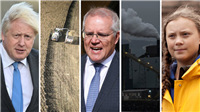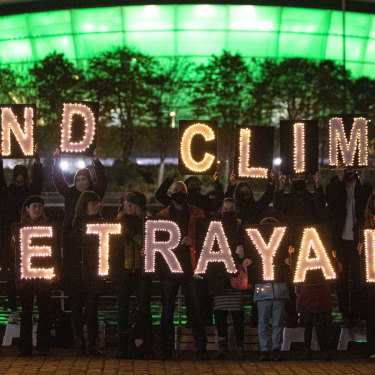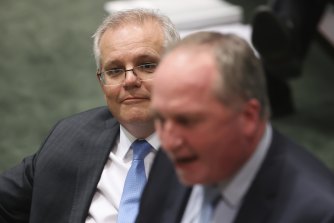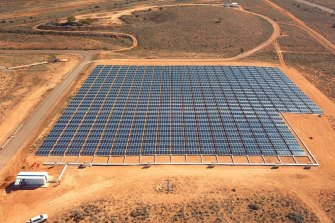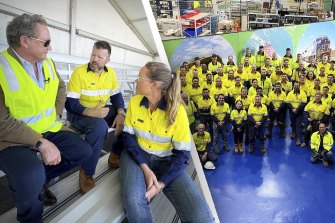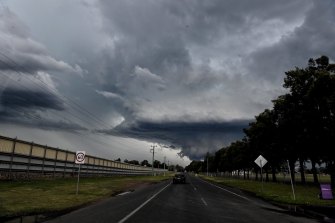By Nick O'Malley and Nick Toscano
Not what it seems: Indonesia has cast doubt on what has been touted as one of the big wins in Glasgow.Credit:AP
For anyone with a passing interest in climate and environment politics and policy, there was simply no escaping the Conference of the Parties in Glasgow this year.
By any analysis the commitments made by the 197 signatories to the Paris Agreement made in Glasgow in November constituted too little action to halt global warming, made way too late.
But, in the weeks since it ended, something like a consensus has emerged that its achievements were significant.
The Glasgow summit attracted worldwide attention.Credit:Alex Ellinghausen, Bevan Shields, Getty Images,
Firstly, it proved that the Paris Accord has held and can function. Secondly, it cemented the more ambitious target of holding warming to 1.5 degrees as the central focus of efforts over 2 degrees, which many nations had sought to entrench in Paris in 2015.
For the first time, a UN document called specifically for coal to be phased down (rather than out, as an earlier draft had put it) and huge commitments were made by many nations to reduce logging and fossil fuel use.
Whether that 1.5 degree target can be achieved is more than in doubt. An analysis by the International Energy Agency found that if every commitment announced at the conference be kept – and that is a huge if – the world remains on track for 1.8 degrees warming.
At the end of the conference, United Nations Secretary-General Antonio Guterres announced the effort to reach 1.5 degrees was still alive, but on life support.
It did not help that within days of the conference ending, Australia, New Zealand, and the EU all signalled they would not increase their targets before next year’s COP27 Climate Summit, as they had been called upon to do in the Glasgow Pact they had just signed.
Australian politics reacts
In the face of a public pressure campaign waged by some of Australia’s most powerful friends, including the UK and the US, Prime Minister Scott Morrison eventually announced a net zero by 2050 target and agreed to attend the COP.
There he confirmed that Australia’s 2030 target would remain 26 to 28 per cent, bolstered by a projection that the actual cut would end up being as high as 35 per cent.
The support of National’s leader Barnaby Joyce was required to allow the government to agree to net zero emissions by 2050.Credit:Alex Ellinghausen
Both targets are well below what scientists say would be a fair contribution to the global effort to hold warming to 1.5 degrees later this century, and disappointed observers here and abroad.
After the conference, Labor announced its own policy which included a target of 43 per cent by 2030, also short of the action scientists believe is necessary.
Indeed, only the Greens policy of reducing emissions by 75 per cent by 2030 is in line with the reductions the Climate Council has cited as necessary.
Despite this, the Labor policy was generally well-received by climate observers.
“Labor’s plan helps bridge the gap between the Morrison Government’s do-nothing approach and state government and business leaders who are forging ahead to create jobs and grow our nation’s prosperity by slashing emissions this decade,” said the Climate Council’s chief executive Amanda McKenzie.
Richie Merzian, director of energy and climate policy with The Australia Institute, said many in the field were simply exhausted by the climate wars that have cruelled climate policy for a generation in Australia, and willing to welcome any real movement by the major parties.
With News Ltd newspapers supporting the government’s net zero plan and the Business Council of Australia backing Labor’s targets, there was reason by year’s end to believe those wars may be ebbing.
The energy revolution
Buoyed by the findings of a landmark 2020 report by the International Energy Agency that solar power had become the cheapest energy created in history, an international movement coalesced around the COP to make this the year that fossil fuels were finally knocked out of the economy – or at least peaked.
Sun Cable is the world’s largest solar farm, delivering power from the Australian outback to the Northern Territory and Singapore.Credit:
This was not a fringe movement either. As COP host Boris Johnson was a cheerleader, and since the UK had managed to shrink its coal use from 25 per cent of the nation’s power to under 1.6 per cent, his was a credible voice. The United States climate envoy John Kerry threw his weight into the effort too and enjoyed the backing of the EU.
At the COP, a group of developed nations raised money to help South Africa shut down its dirty coal industry and in the weeks after, the Asian Development Bank laid out a plan to raise capital to buy out and shut down coal power stations in this region.
But even as a group of 40 nations signed a pledge to abandon coal at the COP, a grim set of unforeseen circumstances was causing coal and gas prices to surge to new records – blackouts engulfing China and India.
An oddly windless northern Autumn had reduced the expected amount of wind power available in Europe just as a cold snap lifted heating demand. With the so-called pipeline of new fossil projects already constricted due to the lingering shock of the COVID-19 downturn and the flow of global capital away from new fossil fuel projects, supplies were failing to keep pace with a sharper-than-expected return in demand, causing a crippling shortage of fossil fuels that would have seemed unthinkable just one year earlier.
Few believe though that the surge in demand will be sustained. Indeed, the first energy shock of the green power era could even drive nations to faster embrace renewable and firming technologies to free themselves from capricious global energy markets.
Business gets on board
With the reshaping of global energy markets now looking more like a practical reality rather than an activist fantasy, the world’s major energy companies began to rebuild themselves.
Andrew ‘Twiggy’ Forrest’s new green venture, Fortescue Future Industries, is taking a modern approach to workplace culture. Credit:FFI/Twitter
Australia is home to some of the world’s biggest resources companies. And as the push to arrest climate change became markedly more urgent this year, investors continued retreating from companies in the business of drilling up planet-heating fossil fuels, pushing the cost of capital higher and triggering a wave of merger and acquisition activity.
BHP, the nation’s largest mining company, has stepped up plans to better align its portfolio with the global decarbonisation mega-trend, striking a deal to sell its entire petroleum division to Perth-based Woodside, and continuing in its efforts to sell out of thermal coal.
Two of Australia’s top oil and gas producers – Santos and Oil Search – agreed to a $21 billion merger in the hope of gaining greater capacity to self-fund their growth projects as financial challenges intensified.
Meanwhile, the influx of new large-scale renewable energy and rooftop solar panels across Australia’s east-coast electricity grid has led to a major shake-up of the market, causing wholesale power prices to plunge to levels where fossil fuel-based generators have been increasingly struggling to stay viable.
In March, the pressure caused EnergyAustralia to announce it would shut down its giant Yallourn coal plant in Victoria’s Latrobe Valley in 2028, four years earlier than scheduled, while AGL has unveiled plans to embark on a historic demerger to split off its carbon-heavy coal- and gas-fired power stations after sinking to a $2 billion full-year loss.
But it was not just the big emitters that began preparing for a new world. Over the year it became clear that the financial sector was on board with the broader decarbonisation movement, and in this country at least appeared to be more enthusiastic to act than the government itself.
Chief executive of the Carbon Market Institute John Connor says it was clear from conversations with Australian executives this year that climate was no longer a fringe issue, but front and centre in the nation’s boardrooms.
He notes that the price of carbon credits on the Australian market climbed from around $16.50 at the start of the year to almost $50.
This year it became clear that the EU is determined to introduce some form of carbon border tariff, penalising carbon-intensive products from crossing its border. Should the policy succeed it is likely to be replicated, driving a virtuous circle of greening-for-profit in the global supply chain.
It was also the year that hydrogen became a darling of governments pursuing new clean industries and investors seeking to make a clean buck.
In Australia, Andrew Forrest pumped money into projects to build the electrolysers to make hydrogen and renewable energy infrastructure to power them.
Forrest was rewarded with an audience with Joe Biden at COP where he was invited to join the so-called “First Movers Coalition”, a vehicle the US President was backing to help accelerate the expansion of new green industries.
But still the world warmed
With such a focus on climate policy and politics, and with south-eastern Australia enjoying a period of weather brought about by the La Nina weather pattern, it was possible at times to lose sight of the pace of change in our climate, despite the floods and tornadoes that struck the region.
It was not this way in northern Australia, or in other parts of the world.
La Nina weather conditions have brought record-breaking wet weather to the Australian east coast. Credit:Nick Moir
Researchers Rohan Fisher and Neil Burrows, of Charles Darwin University and the University of Western Australia respectively, found that in October and November alone, extreme weather conditions contributed to 120,000 square kilometres of Australia’s tropical savannah and rangelands burning.
With heating increasing, the world has slipped into what they call a global age of fire, a pyrocene.
A guide to the environment, what’s happening to it, what’s being done about it and what it means for the future. Sign up to our fortnightly Clear Air newsletter here.
Most Viewed in Environment
Source: Read Full Article
